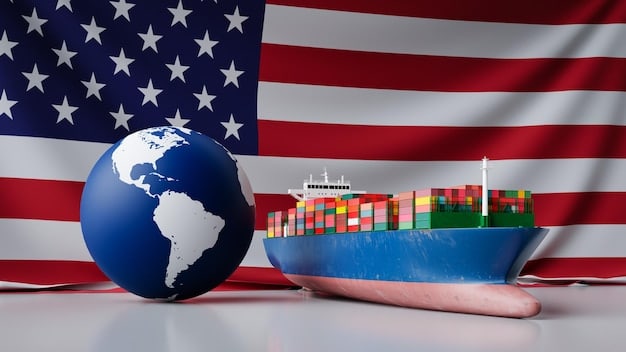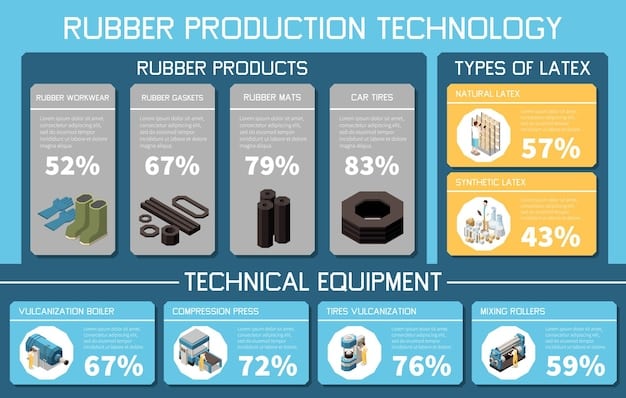The Impact of Trade Policies on US Businesses: An Overview

The Impact of Trade Policies on US Businesses: A Comprehensive Overview explores how tariffs, quotas, and trade agreements shape the competitive landscape, affecting supply chains, pricing, and overall business strategy in the United States.
Understanding the impact of trade policies on US businesses: a comprehensive overview is crucial for navigating today’s global economy. These policies can drastically alter the competitive landscape, impacting everything from supply chain management to pricing strategies.
Understanding the Basics of Trade Policies
Trade policies are government regulations that shape international commerce. They influence the flow of goods and services between countries, affecting the competitive environment for US businesses both domestically and abroad.
These policies can take many forms, each with distinct effects on the US economy. Let’s delve into some key types of trade policies and their significance.
Types of Trade Policies
Trade policies are implemented through various mechanisms. Here are some of the most common:
- Tariffs: Taxes imposed on imported goods, increasing their cost for consumers and businesses.
- Quotas: Limits on the quantity of specific goods that can be imported, restricting supply and potentially raising prices.
- Embargoes: Complete prohibitions on trade with a particular country, usually for political reasons.

Trade Agreements: Shaping the Landscape
Beyond tariffs and quotas, trade agreements play a pivotal role.These agreements set the rules for commerce between nations.
- Free Trade Agreements (FTAs): Agreements that eliminate or reduce trade barriers between member countries, promoting increased trade and economic integration.
- Customs Unions: Agreements where member countries eliminate internal trade barriers and adopt a common external tariff policy.
- Common Markets: Agreements that include the features of a customs union and also allow for the free movement of labor and capital.
In summary, understanding the nuances of trade policies—from tariffs to trade agreements—is vital for US businesses to navigate the global marketplace effectively.
The Positive Impacts of Trade Policies on US Businesses
While trade policies can present challenges, they also offer significant opportunities for US businesses. These policies can foster growth, innovation, and competitiveness in the global market.
Here are some ways in which trade policies can positively impact US businesses:
Expanding Market Access
Trade agreements, particularly Free Trade Agreements (FTAs), can provide US businesses with access to new and larger markets. This expansion allows companies to increase their sales and revenue by reaching a wider customer base.
By reducing or eliminating tariffs and other trade barriers, FTAs make it easier for US companies to compete in foreign markets.
Boosting Exports
Lower trade barriers encourage the export of US goods and services, leading to increased production and job creation domestically.
- Trade agreements incentivize foreign countries to purchase US products, boosting the export sector.
- Increased exports can lead to economies of scale, making US businesses more efficient and competitive.
- Export-related jobs tend to pay higher wages, contributing to overall economic prosperity.
Attracting Foreign Investment
Open trade policies can make the US an attractive destination for foreign investment. Foreign companies may choose to establish operations in the US to take advantage of its access to global markets.
Foreign investment can bring new technologies, expertise, and capital into the US economy, fostering innovation and growth.
In essence, strategic trade policies can create a virtuous cycle of economic growth, benefiting US businesses and the overall economy.
The Negative Impacts of Trade Policies on US Businesses
While trade policies aim to promote economic growth, they can also have adverse effects. US businesses sometimes face challenges due to shifts in international trade.
Understanding these potential downsides is crucial for businesses to prepare and adapt. Let’s consider some common negative impacts:
Increased Costs and Tariffs
Tariffs, imposed on imported goods, can significantly increase production costs for US businesses that rely on foreign inputs. These higher costs can reduce competitiveness and profitability.
For example, tariffs on steel and aluminum have led to higher prices for manufacturers in various sectors, impacting their bottom line.
Supply Chain Disruptions
Trade restrictions and embargoes can disrupt supply chains, making it difficult for US businesses to source necessary materials and components. This can lead to production delays and increased uncertainty.
Companies may need to find alternative suppliers, which can be time-consuming and costly, or even redesign products to use locally available materials.
Competitive Disadvantages
Trade policies can create an uneven playing field, disadvantaging US businesses compared to foreign competitors. For instance, subsidies provided to foreign companies can make it challenging for US firms to compete in international markets.
These disadvantages can result in lost sales, reduced market share, and even business closures.

In conclusion, while trade policies have the potential to boost growth, US businesses must also be aware of and prepared for the potential negative impacts, such as increased costs and supply chain disruptions.
Adapting to Changing Trade Policies: Strategies for US Businesses
Given the dynamic nature of trade policies, US businesses must be proactive in adapting to change. Implementing flexible strategies can help companies mitigate risks and seize new opportunities.
Here are some key strategies for adapting to evolving trade policies:
Diversifying Supply Chains
Reducing reliance on a single supplier or country can minimize the impact of trade disruptions. Diversifying supply chains involves identifying alternative sources for critical materials and components.
Companies are exploring nearshoring (relocating production closer to the US) and reshoring (bringing production back to the US) to enhance supply chain resilience.
Investing in Innovation
Innovation can help US businesses overcome trade-related challenges by developing new products, processes, and technologies.
- Investing in research and development can lead to breakthroughs that reduce production costs and improve competitiveness.
- Adopting advanced manufacturing techniques can enhance efficiency and reduce reliance on imported materials.
- Developing unique and differentiated products can help businesses stand out in the global marketplace.
Staying Informed and Engaged
Keeping abreast of trade policy developments is critical for making informed business decisions. Engaging with industry associations and government agencies can provide valuable insights and influence policy outcomes.
Businesses should monitor trade negotiations, policy changes, and regulatory updates to anticipate potential impacts and adapt their strategies accordingly.
By adopting these strategies, US businesses can navigate the complexities of trade policies and remain competitive in the global economy.
Case Studies: Real-World Examples of Trade Policy Impact
Examining real-world case studies provides valuable insights into the tangible effects of trade policies on US businesses. These examples illustrate both the challenges and opportunities that companies face.
Here are a few illustrative cases:
The Steel Industry: Tariffs and Their Consequences
In recent years, the US imposed tariffs on imported steel to protect domestic producers. While this provided some relief for US steel companies, it also led to higher costs for industries that rely on steel, such as automotive and construction.
This example highlights the complex trade-offs involved in trade policy decisions, where benefits for one sector can come at the expense of others.
The Agricultural Sector: Trade Agreements and Market Access
Trade agreements have opened up new markets for US agricultural products, increasing exports and supporting farm incomes. For example, agreements with countries in Asia and Latin America have boosted demand for US soybeans, corn, and other commodities.
These agreements have also faced opposition from some farmers who worry about increased competition from imports.
The Technology Sector: Intellectual Property and Trade
The technology sector relies heavily on intellectual property protection to maintain its competitive edge. Trade policies that address intellectual property rights are crucial for preventing counterfeiting and protecting US innovation.
Trade disputes over intellectual property can lead to significant economic consequences for technology companies.
These case studies underscore the diverse and far-reaching impacts of trade policies on US businesses across various sectors.
The Future of Trade Policies and US Businesses
The future of trade policies is uncertain, but several trends are likely to shape the landscape for US businesses. Anticipating these developments is essential for strategic planning.
Here are some key trends to watch:
The Rise of Protectionism
Protectionist measures, such as tariffs and quotas, are on the rise in many countries. This trend could limit market access for US businesses and increase trade tensions.
Companies should be prepared for a more challenging global trade environment and consider strategies for mitigating protectionist risks.
The Growth of Digital Trade
Digital trade, involving the exchange of goods and services online, is growing rapidly. Trade policies must adapt to address issues such as data flows, cybersecurity, and digital taxation.
US businesses should be prepared to navigate the evolving regulatory landscape for digital trade.
The Focus on Sustainability
Sustainability is becoming an increasingly important consideration in trade policy. Trade agreements may include provisions related to environmental protection and labor standards.
US businesses that prioritize sustainability may gain a competitive advantage in the global marketplace.
By staying informed about these trends, US businesses can better prepare for the future and capitalize on emerging opportunities.
| Key Point | Brief Description |
|---|---|
| 🌍 Trade Policies Impact | Trade policies shape supply chains and costs for US firms. |
| 📈 Market Access | Trade agreements expand market through tariff reduction. |
| ⚠️ Supply Chain Risks | Trade restrictions can disrupt supply chains. |
| 🌱 Sustainability | Sustainability is a growing factor in trade policy. |
Frequently Asked Questions (FAQs)
▼
The main types of trade policies include tariffs, quotas, subsidies, trade agreements (such as free trade agreements), and regulatory standards. Each one can significantly influence trade flows and market access.
▼
Trade policies can affect costs through tariffs, which increase the price of imported goods. Supply chain disruptions caused by trade barriers can also drive up costs, as firms seek alternative sources.
▼
US businesses can adapt by diversifying supply chains, investing in innovation to reduce import dependence, and staying informed through governmental and industry resources for strategic preparation.
▼
Trade agreements create new market access for exports by creating lower barriers. Successful market access often involves increased exports for US businesses, which boosts jobs and economic benefits.
▼
Staying informed involves monitoring government websites like the USTR, engaging with industry associations, and tracking news from reputable sources such as the Wall Street Journal or other financial publications.
Conclusion
In conclusion, the impact of trade policies on US businesses: a comprehensive overview is a multifaceted issue with implications spanning costs, market access, and supply chain management. As the global trade landscape continues to evolve, proactive adaptation and informed decision-making will be essential for US businesses to succeed.





